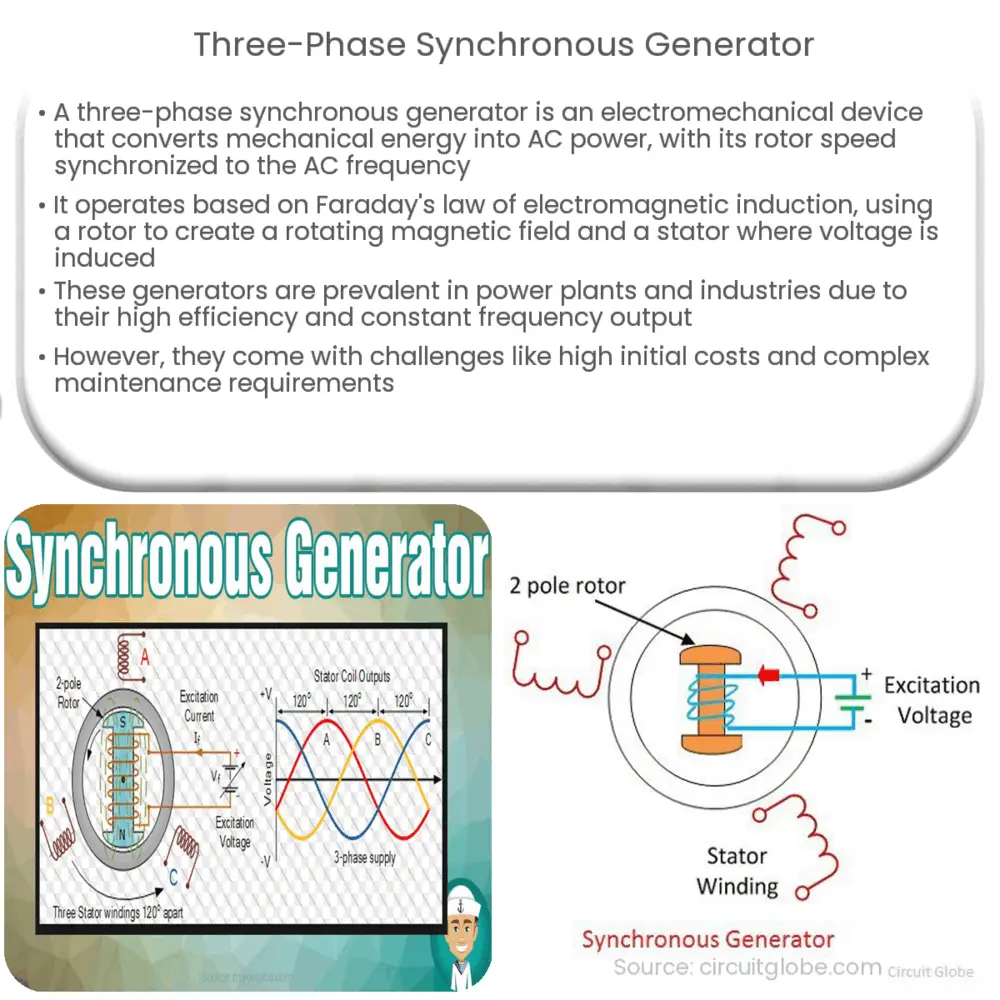Explore the principles, construction, and operation of a Three-Phase Synchronous Generator in our comprehensive guide.

Introduction to Three-Phase Synchronous Generators
A three-phase synchronous generator is a vital part of many power systems. It is an electromechanical device that converts mechanical energy into electrical energy, producing alternating current power. It is referred to as ‘synchronous’ because the speed of the rotor is synchronized with the frequency of the alternating current it produces.
Working Principle of a Three-Phase Synchronous Generator
The working principle of a three-phase synchronous generator is based on Faraday’s law of electromagnetic induction. This law states that an electromotive force (EMF) is induced in a conductor when it moves through a magnetic field. The rotor, which is the rotating part of the generator, creates a rotating magnetic field. The stator, the stationary part, houses the armature windings where the voltage is induced.
- Excitation System: The excitation system provides the necessary direct current (DC) to the rotor windings to produce the magnetic field.
- Prime Mover: The prime mover provides the mechanical power required to rotate the rotor. This can come from various sources such as a turbine powered by steam, water, or gas.
- AC Output: The rotating magnetic field cuts across the stator windings, thereby inducing an electromotive force (EMF). The induced EMF is three-phase due to the three separate windings in the stator.
Construction of a Three-Phase Synchronous Generator
A three-phase synchronous generator primarily consists of two main parts – the rotor and the stator.
- The Stator: The stator is the stationary part of the synchronous generator. It contains the armature where the power is generated. The stator windings are arranged in such a way that, when excited by the rotating magnetic field of the rotor, they produce a three-phase output.
- The Rotor: The rotor, also known as the field winding, rotates inside the stator. It is excited by a DC source, creating a magnetic field.
Understanding the operation of a three-phase synchronous generator is integral to comprehending the larger picture of power generation and transmission. In the next part, we will delve deeper into the characteristics and uses of these generators, their advantages, and the challenges associated with their use.
Characteristics and Uses of Three-Phase Synchronous Generators
Three-phase synchronous generators are commonly used in power plants, industries, and in the generation of grid electricity. They have the advantage of producing power at a constant frequency, regardless of the load or speed of the prime mover. This is particularly useful in applications where a stable frequency is vital, such as in data centers and hospitals.
Advantages of Three-Phase Synchronous Generators
- High Efficiency: Synchronous generators are generally more efficient compared to other types of generators. They are capable of converting a high percentage of the input mechanical energy into electrical energy.
- Power Factor Control: Unlike other generators, the power factor of a synchronous generator can be controlled. By adjusting the field excitation, the generator can operate at a lagging, leading, or unity power factor.
- Constant Frequency: As previously mentioned, synchronous generators produce power at a constant frequency, which is crucial in many applications.
Challenges Associated with Three-Phase Synchronous Generators
Despite their many advantages, three-phase synchronous generators are not without their challenges. These include the high initial cost, the need for a separate DC source for field excitation, and the complexity of speed control. Moreover, they require a cooling system to manage the heat produced during operation, adding to the maintenance requirements.
Conclusion
The three-phase synchronous generator plays a pivotal role in the generation of electrical power. Its ability to produce power at a constant frequency and its high efficiency make it a popular choice for power generation in various sectors. Although it comes with its own set of challenges, the benefits it offers are substantial. An understanding of the principles, construction, and operation of a three-phase synchronous generator is therefore essential for anyone involved in the field of electrical engineering and power systems. As technology continues to evolve, it is expected that further improvements in the design and operation of these generators will only enhance their utility and efficiency.

